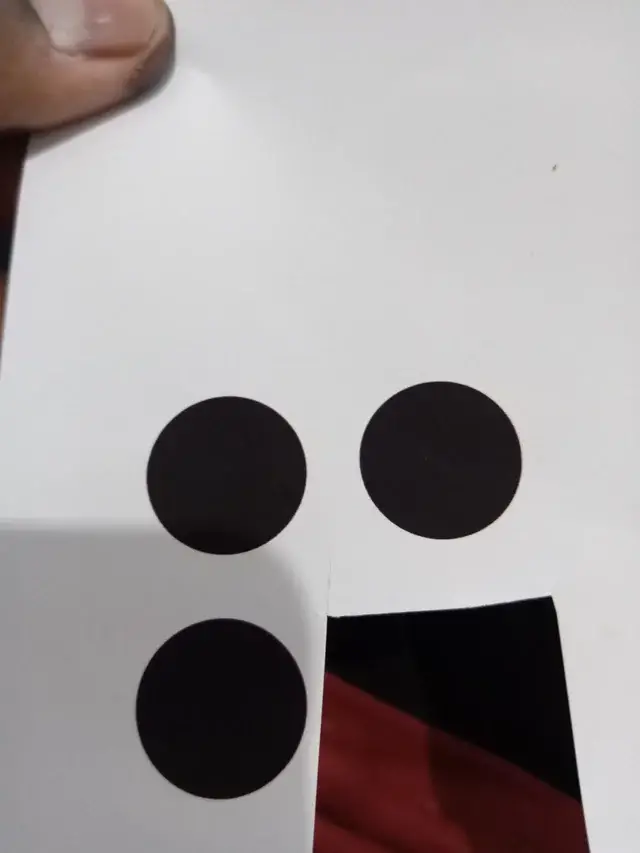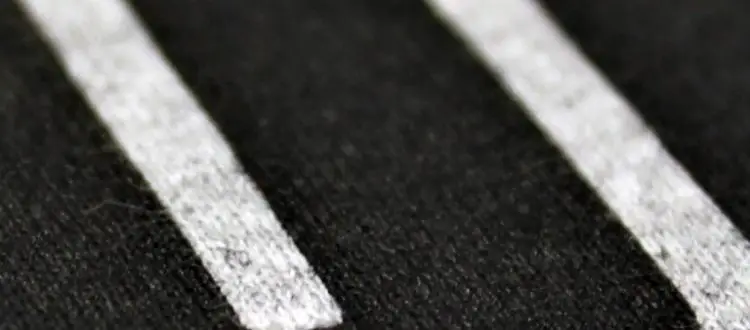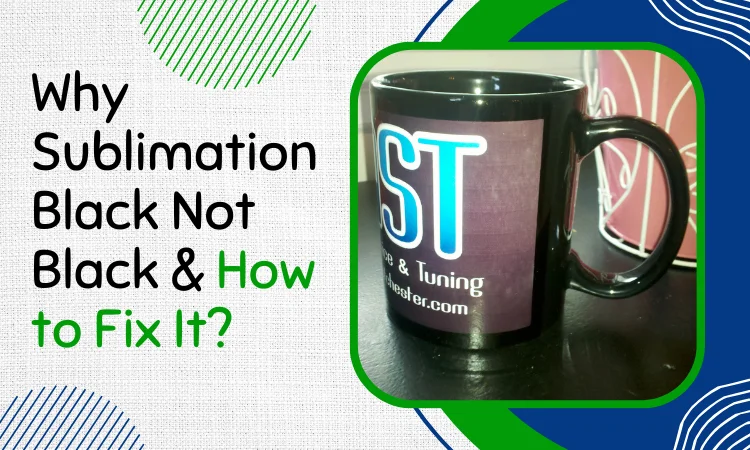Sublimation is a complicated yet popular process that requires particular expertise and experience. One issue we often face is not being able to print true black. For example, sublimating the color black may turn it into lighter shades or a brownish or grayish hue. But what’s the reason for sublimation black not black?
The problem could be in the printer ink; in this case, you may have to unclog the ink nozzle or change the color settings. Overcooking or undercooking is another prime cause for this. To solve those problems, you must use the right temperature and pressure for the appropriate amount of time. The time, temperature, and pressure would depend on what type of substrate you are using. To get the best result, one or two experimental tries may be required.
Sublimation black may become dull or a completely different color depending on the cause. So, let’s find out all the possible reasons and solutions for it.
Sublimation Black Not True Black Rather Faded or Dull: Reasons and Solution
The most common problem people face with sublimating black is that the black is fading or dull. Sometimes the printer is not printing black at all.

Why Does My Black Sublimation Look Faded?
Fading sublimation is usually a product of incorrect heat settings on the heat press. In some cases, it may be because of the sublimation paper or even the printer.

Reason One: Incorrect Time, Temperature, or Pressure Setting on the Heat Press
Faded black in sublimation is a problem that happens a lot. It’s usually caused by incorrect timing, temperature, or pressure settings on the heat press during the transfer process. When these are not right, the sublimation ink can get overheated, and your image can end up looking faded and washed out.
Solution:
To prevent this from happening, it’s crucial to follow the recommended settings given by the manufacturer. Also, you need to consider the type of substrate you’re using because different materials might require different heat press settings.
For example, if you are using polyester fabric, the ideal temperature setting would be between 200 and 205 degrees Celsius for about 25 seconds.
Pressure plays a crucial role in color output. If the pressure is too low, your image will look faded. Heat presses do not have any gadgets to measure pressure, but generally, on most substrates, the optimum pressure is 40 psi.
Moreover, because every heat press is different, you need to be extra careful and make sure you double-check the settings for your specific heat press model. Use a temperature gun to measure the exact temperature.
The recommended temperature in some heat presses maybe 400 degrees, but in reality, it is 5-10 degrees cooler or warmer.

Reason Two: Wrong Side of the Paper
Your print may come out faded if you are printing on the wrong side of the paper. A sublimation paper is coated on one side, which is the side on which you print. If your image is printed on the wrong side, it will appear faded.
Solution:
Almost all papers have a watermark that indicates which side to print on, but for those that do not, you should print on the bright white side.
Why Is My Sublimation Not Printing Black?
If your printer is not printing black, it could be because of a problem with the printer. This is more likely to occur if you are using the printer after a long break.
General Solution:
Normally, there might not be a serious issue with the printer. In that case, you should try the following mentioned solutions and see if your printer works normally or not.
- Simply restarting the printer should fix the problem. Try unplugging the printer and keeping it turned off for a few minutes. Then start it and try again.
- Check if all the plugs are connected to the printer correctly such as power cables and other cables.
If these does not fix the problem, then it could be a clogged ink nozzle. Follow the procedures described below to unclog the ink nozzles.
Reason: Clogged Ink Nozzle
Not using a printer regularly can clog the ink nozzles, which may be the reason why your printer is not printing black. If that’s the case, you need to clean the printhead.
Solution:
You can easily clean the printhead from the control panel of your printer. Most printers have a function to check and clean the nozzles. You can use that function to solve your problem. Refer to the printer’s manual or contact customer service to learn how to clean the printhead.
If that doesn’t solve your problems, you need to clean the printhead manually. There are usually two well-known methods.
Method One: Using Hot Water
- Go into the maintenance menu then go to settings then to ink cartridge replacement and press start.
- Open the top of the printer and unplug it.
- You should find the ink cartridges loosened up. Slide them to uncover the foam pads.
- Put hot water in the foam pads using a syringe. This will soften up the printheads.
- Wait for five minutes then start the printer and do a nozzle check.
- If the result is not up to the mark, repeat the same process.
Method Two: Priming the Ink
If this method doesn’t work, you will have to prime the ink. To prime the ink, you will have to-
- Repeat steps 1 and 2.
- Place a paper towel along the bottom, folded into thirds. Make sure the towel stays under
- Take an empty syringe and fill it up with air.
- Go to the problem color, in this case, black.
- Push down the syringe all the way. If the printhead is clogged, you should feel resistance.
- Then again perform a nozzle check.
By following these steps, you should be able to fix your printer. If the instructions here are a bit confusing, here is a video explaining the process better:
Your problem may be fixed for now, but how do you get “true black” every time you print? In the next chapter, we will reveal some tricks for getting the best shade of black.
How Do You Get True Black When Sublimating?
To make your black sublimation darker, it’s important to apply the exact heat and pressure for the appropriate amount of time. But in some cases, maybe you can print an even better shade of black. There are also some methods to generally make all sublimation brighter, which we will discuss another time.
Tip One: Use the Proper Color Settings
To get the best shade of black, you can tweak your color settings on your printer. Printers usually use CMYK mode for printing.
The common misconception is that you use 0 for cyan, magenta, and yellow and 100 for black. But rather, it would be better to combine all four colors to achieve a deep, dark shade of black. The color settings should be C = 75, M = 68, Y = 67, and K = 90.

However, the exact amount of each color you need to use can depend on factors like the type of ink and paper you’re using and your printer’s color profile.
To ensure that your black is balanced, you can create a gray that is 50% CMYK and adjust the CMY values until it looks neutral (not tinted with any other color). Then, you can double the values to get a deep black.
Tip Two: Use High-Quality Sublimation Paper
Sublimation transfers are usually colorful and clear, but they might not have consistently dark black tones, especially for designs that use black heavily. The good news is that you can fix this by using a sublimation paper that releases more ink as a gas dye when heated.
If you’re looking for the best sublimation paper to transfer black logos and designs, you should go for the Touch Print XP HR. This paper is superior to other options for retaining black dyes and colors. However, if you’re on a tight budget, you could consider the Neenah Jet Cold DHS as a viable alternative. It also produces great results.
Why Sublimation Black Turning Into Another Color?
Apart from printing a dull or faded shade of black, sometimes the result can be an entirely different color. Here is what you do when faced with this.
Why Does My Sublimation Black Look Brown?
Sublimation black can appear brown if the temperature is too high or if the ink is not fully sublimated into the substrate.
Solution:
There are steps you can take to fix the sublimation black that appears brown-
- Make sure that you’re using good quality sublimation paper and have “no residual regular ink.”
- Print a solid black sheet and cut it into test strips to experiment with different dwell times and low pressure.
- It’s also important to check your press for hot or cold spots using a temperature gun to ensure consistency.
- If the color remains brown after timed trials, gradually lower the temperature and combine the test with lower heat and a shorter time.
- You can also experiment with color profiles, starting with various mixes of black to find the optimal color.
Once you have dialed in the correct temperature and timing, most colors will improve too. It may take some time to find the perfect combination!
Why Does My Sublimation Black Look Blue?
Black sublimation may turn out a bit blueish if the color settings are incorrect.
Reason: Incorrect Color Settings
Sublimation printers use two types of color settings, CMYK and RGB. Usually, most printers use CMYK (cyan, magenta, yellow, and black). Black sublimation may turn up with a blue tint in this setting. If that happens, check and change your color settings to RGB.
Solution:
Changing the color settings of your sublimation printer from CMYK to RGB can fix the black sublimation turning blue. The color code to produce the perfect shade of black should be “hex #000000.”

Why Is My Black Sublimation Turning Green?
When black sublimation ink turns green, it’s usually because it hasn’t been cooked long enough.
Reason: Undercooking
Undercooking means that the ink hasn’t fully sublimated and fused with the substrate, causing the color to shift. Another reason could be the type of fabric you are using. If it’s not a 100% polyester fabric, the color output may not be what you expected.
It may be tricky, but it is possible to sublimate on 65-35 polyester-cotton fabric.
Solution:
To fix this, you’ll want to increase the dwell time on your press, which means leaving the substrate under heat for a longer period of time. You can experiment with different dwell times until you find the one that gives you the best results. Just be careful not to overcook the substrate, which can cause other issues.
It would be best to own a temperature gun rather than rely on the display to measure the actual heat on the heat press. Heat press displays may not be showing the actual temperature.
Why Does My Sublimation Black Look Red?
If you’re noticing that your sublimation black looks red, it could be due to overcooking.
Reason: Overcooking
Overcooking happens when the heat press temperature and pressure settings are too high or the transfer time is too long. This can cause the ink to burn, resulting in a color change.
Solution:
To get better results, try using a lower temperature for a shorter period of time. Combine a lower temperature with a shorter dwell time and see if the result improves. Getting a temperature gun is highly recommended to determine the actual temperature of the heat press. Find the optimal time and temperature for an accurate shade of black.
If the issue persists even after adjusting your heat press settings, you might try experimenting with different ink, paper, or substrate combinations. Don’t hesitate to reach out to your sublimation supplier for advice or troubleshooting tips.
These are all the reasons and their solutions for sublimation black not turning out as black. But no worries; in some cases, sublimation mistakes can be fixed.
FAQs: Why Sublimation Black Not Black
Can You Sublimate On Black?
Yes, you can sublimate on black-colored fabric. For that, you will need a white-colored heat transfer vinyl as a base layer. You will have to heat press the heat transfer vinyl and then sublimate it on top of it.
Why Are My Sublimation Colors Dull?
Sublimation ink will look dull on the sublimation paper but will come to full color by heating and applying pressure. It’s absolutely normal for sublimation ink to look dull when it’s printed on sublimation paper for the first time.
Why Does My Sublimation Look Burnt?
Your sublimation may look burned if you have applied too much temperature or applied heat for longer than necessary. Try sublimating with less temperature and a shorter period.
Conclusion: Why Sublimation Black Not Black
Why Sublimation Black Not Black? Sublimation black not black is a common issue faced by printing business owners all over the world. This problem can be caused by various factors, including incorrect color management, using the wrong materials, and making mistakes during the process.
By utilizing proper color management techniques, high-quality materials, and an optimized printing process, sublimation printing can produce rich and vibrant black colors.




